Remember - if you want to see a larger version of any picture - just double click on it
Day 14 January 10th 2009
One of the issues which is focusing the collective mind at the moment, is flying back from Ushuaia to anywhere. Most people are book on Argentina Aerolineas (or one of its variations) and everyone has their tale to tell of cancelled flights, re-routed flights, lost bookings etc. We now count ourselves lucky that our flight time was only changed three times and the airport changed once. The worst delay we have heard of is 2 ½ days together with a refusal (in a Spanish manana way) to issue any written confirmation of the delay so that a claim for costs could be made on travel insurance. The airline has such a bad record for loosing luggage that the ship asks for donations of unwanted clothes to keep in store for the regular arrival of travellers without their luggage. We were asked to supply our tickets details to a ground agent in Ushuaia before we left and the theory is that they will confirm our flights and get boarding cards or take appropriate action to deal with whatever surprises the airline come up with. Whether that works or not will be revealed when we get back to land.
Petermann and Pleneau Islands
Petermann Island lies just below the Lemaire Channel southwest of Hovgaard Island, in the Wilhelm Archipelago. It was discovered by the Dallman expedition of 1873-4 and named after August Petermann, a German geographer and supporter of polar exploration. The French explorer Jean-Baptiste Charcot and his vessel "Pourquoi Poi?" over-wintered here in 1909. Charcot named the small cove on the southwest side of the island Port Circumcision for the fact that he discovered it on January 1st and named it for the Feast of the Circumcision. On the beach near the cove is an abandoned Argentinean refuge hut built in 1955. There is also a memorial cross nearby for three British scientists who died near here in August 1982. Petermann Island is home to Adelie penguins (500 breeding pairs), the most southerly colony of Gentoo penguins in Antarctica (2000 breeding pairs) and blue eyed shags. Grass and moss can also be found on the northern section of the island once snow melts. There are stunning views from Petermann island both looking north towards the Lemaire Channel and south to the mountainous landscape of Graham Land.
Pleneau Island is a small (1,28 km) low island lying to the west of Booth Island and north of Hovgaard Island. It was originally charted by Charcot during his 1903-05 French Antarctic Expedition and named for the expedition's photographer, Paul Pleneau. The island is home to more than 500 breeding pairs of gentoo penguins as well as south polar skuas and kelp gulls. The shallow waters north and west of the island are known as an "iceberg graveyard" due to the number of large old bergs that often get forced into the shallows by the wind and currents, and remain trapped and grounded until they break up.
A great morning observing Penguins, one seal and a nice bit of walking in rather thick snow. The scenery was stunning. It rained a fair bit but that did not spoil the morning.
We saw our first Adelie penguin, whilst many
of the colonies are mixed breeds, the Adelies
here have declined on this island from 80% to 20% over the past few years. It is said that this is a consequence of climate warming because Gentoos like slightly warmer climates and therefore as the peninsula gets warmer, they take over the breeding grounds. Gentoos tend to be very curious about humans and will come up and look at you in a most quizzical way whereas Adelies just get on with life and totally ignore you.
There are many chicks (both Adelie and
Gentoo) about in various stages of development. Some are still furry whilst others are into first feathers.
The penguins tend in the main to follow set tracks when walking around
the island and the tracks are usually stained a pink / purple colour from the krill they eat, the remains of which they deposit as they walk.
On the island, there is a Refugio for use in
emergency and also a memorial to the three British scientists who disappeared on the
island in 1982 (and are now presumed dead). The beauty of the scenery is again too large for a single picture to convey.
The Antarctic Treaty visitor guidelines for Petermann Island are at http://www.ats.aq/siteguidelines/documents/pdf_ingles/Petermann_ingles.pdf
We have signed up for the afternoon "silence zodiac trip". The idea is that we go far out into the Antarctic sea in a Zodiac, find a nice quiet spot, turn the engine off and just enjoy the Antarctic silence or noises or whatever animals come to visit us. Nobody has ever done this before on one of these trips and the guides are somewhat curious as to how it will turn out.
Well, in the Antarctic, nothing works out as planned. Having got into the zodiacs, the snow started coming down quite hard, the sea got up and we were soon soaking and very cold. So it was rapidly decided that we would "contemplate" another day and just look at icebergs this afternoon.
If ever you wanted to set up a second hand iceberg shop, this would be the place to do it. We are moored at the head of a very long cove and as you zodiac into it, you come across approximately100 old icebergs
of all shapes and sizes.
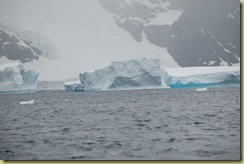
This one is about 60 metres tall and therefore
has about another 540 metres below the water. A rough estimate gives it about 6,000,000 cubic metres of fresh water (enough to provide the average household in the UK with fresh water for 800 years).
This is a remnant of a glacier, one can tell that from the rocks and soil on the surface of the ice.
This one is about to calve and that is why you can see two more icebergs behind through the window in the ice.
As we wait for dinner and also sailing north through the Lemaire Channel which is one of the greatest spectacles in Antarctica, outside of the window pops up a wonderful mountain view.
We went onto the Bridge for the Lemaire Channel experience. There was a certain amount of tension present as the Captain slowly took the Ioffe through the Channel (about 7kms long). It is narrow at its entrance
and exit
and in order to avoid underwater rocks and icebergs near the exit, the ship has to perform a strange 360 degree rotation in the middle of the channel in order to effectively move sideways as it approached the exit.
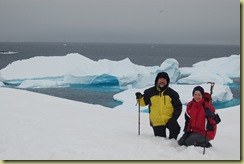
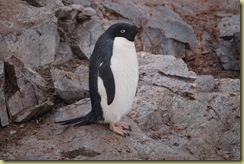
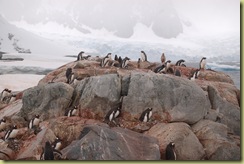
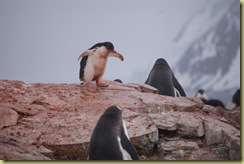
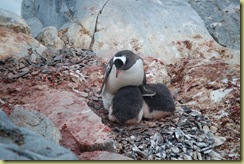
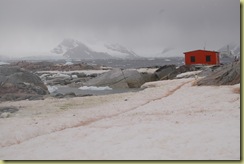
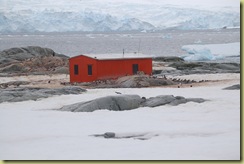
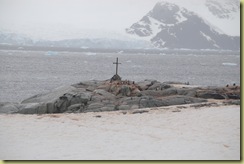
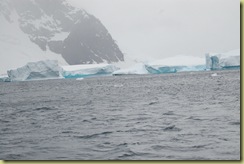

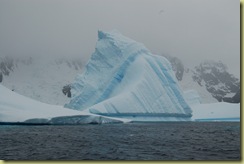
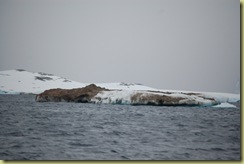
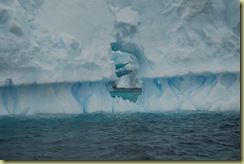
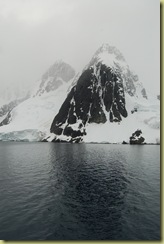
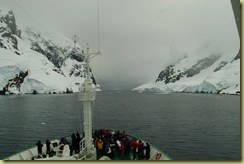

No comments:
Post a Comment